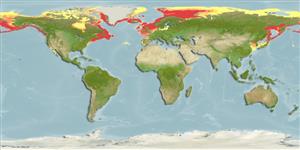Common names from other countries
Environment: milieu / climate zone / depth range / distribution range
Écologie
; profondeur 0 - 1000 m (Ref. 116516), usually 10 - 100 m (Ref. 116516). Polar
Northern Atlantic, Pacific Ocean and the Arctic Ocean: Europe, USA, Scotland and Sea of Japan. Temperate to polar.
Length at first maturity / Taille / Poids / Âge
Maturity: Lm ? range ? - ? cm Max length : 1.3 cm TL mâle / non sexé; (Ref. 281)
Description synthétique
Morphologie
Body: Oblong; moderately elevated. Valves: Dorsal surface, smoothish except for irregular concentric growth ridges and a very fine sandpaper effect; Color, whitish, cream, light-orange or rarely marked with brown. Girdle: Resembles sandpaper, with tiny, closely packed gravelly scales (Ref. 281).
Habitat: On or under stones; rocky shores (Ref. 293). Found from subtidal to 100 m (Ref. 75835).
Life cycle and mating behavior
Maturité | Reproduction | Frai | Œufs | Fécondité | Larves
Members of the class Polyplacophora are mostly gonochoric. Life cycle: Eggs hatch into lecitotrophic planktonic trocophore larvae (no veliger stage) which later metamorphose and settle on the bottom as young adults.
Burghardt, G. and L. Burghardt. 2006. (Ref. 281)
Statut dans la liste rouge de l'IUCN (Ref. 130435)
statut CITES (Ref. 108899)
Not Evaluated
Not Evaluated
Utilisations par l'homme
| FishSource |
Outils
Plus d'informations
Taille/ÂgeCroissanceLongueur-poidsLongueur-longueurMorphologieLarvesAbondance
Sources Internet
Estimates based on models
Preferred temperature
(Ref.
115969): 0.1 - 10.2, mean 2.8 (based on 2507 cells).
Vulnérabilité
Low vulnerability (10 of 100).
Catégorie de prix
Unknown.
